How Fast Fashion Contributes to Climate Change: A Detailed Essay
VerifiedAdded on 2023/06/16
|6
|1477
|424
Essay
AI Summary
This essay delves into the significant role of fast fashion in driving climate change. It highlights the rapid growth of the fashion industry and the increased prevalence of fast fashion, leading to substantial environmental impacts. The essay discusses the immense carbon footprint of the fashion industry, with statistics indicating its contribution to greenhouse gas emissions. It explores the factors contributing to increased consumption and waste, such as shorter clothing lifespans and rising affordability. Furthermore, the essay examines the environmental impact of textile production, particularly in South Asian countries reliant on coal-fired power plants. It also differentiates between the emissions from synthetic and natural fibers, emphasizing the growing reliance on polyester and its fossil fuel origins. The essay concludes by acknowledging industry initiatives to reduce their carbon footprint, such as switching to green energy and recycling plastics, and emphasizes the importance of returning to slow fashion practices. Desklib provides access to similar essays and resources for students.
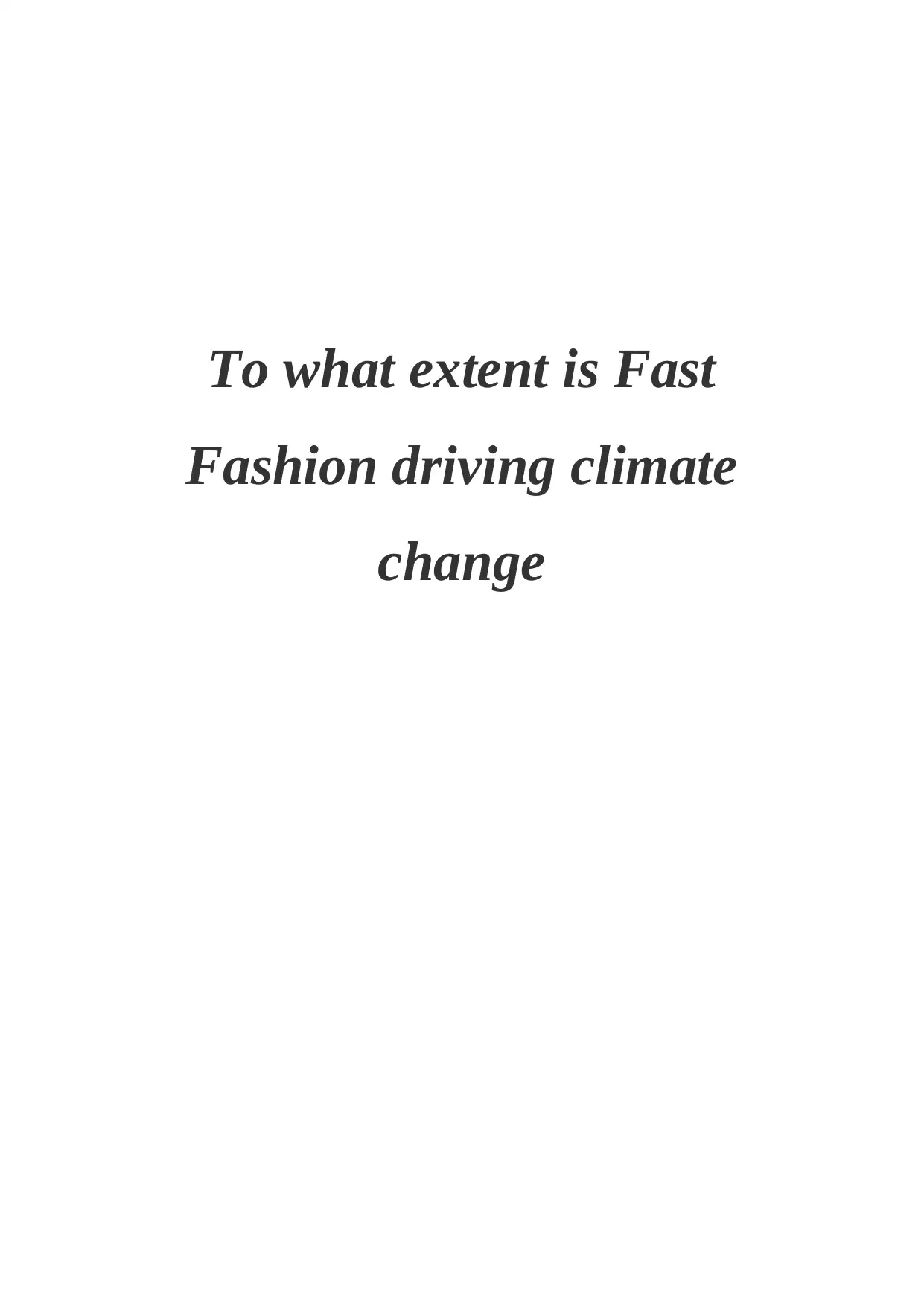
To what extent is Fast
Fashion driving climate
change
Fashion driving climate
change
Paraphrase This Document
Need a fresh take? Get an instant paraphrase of this document with our AI Paraphraser

Table of Contents
Introduction...........................................................................................................................................3
Main Body.............................................................................................................................................3
Conclusion.............................................................................................................................................5
References.............................................................................................................................................6
Introduction...........................................................................................................................................3
Main Body.............................................................................................................................................3
Conclusion.............................................................................................................................................5
References.............................................................................................................................................6
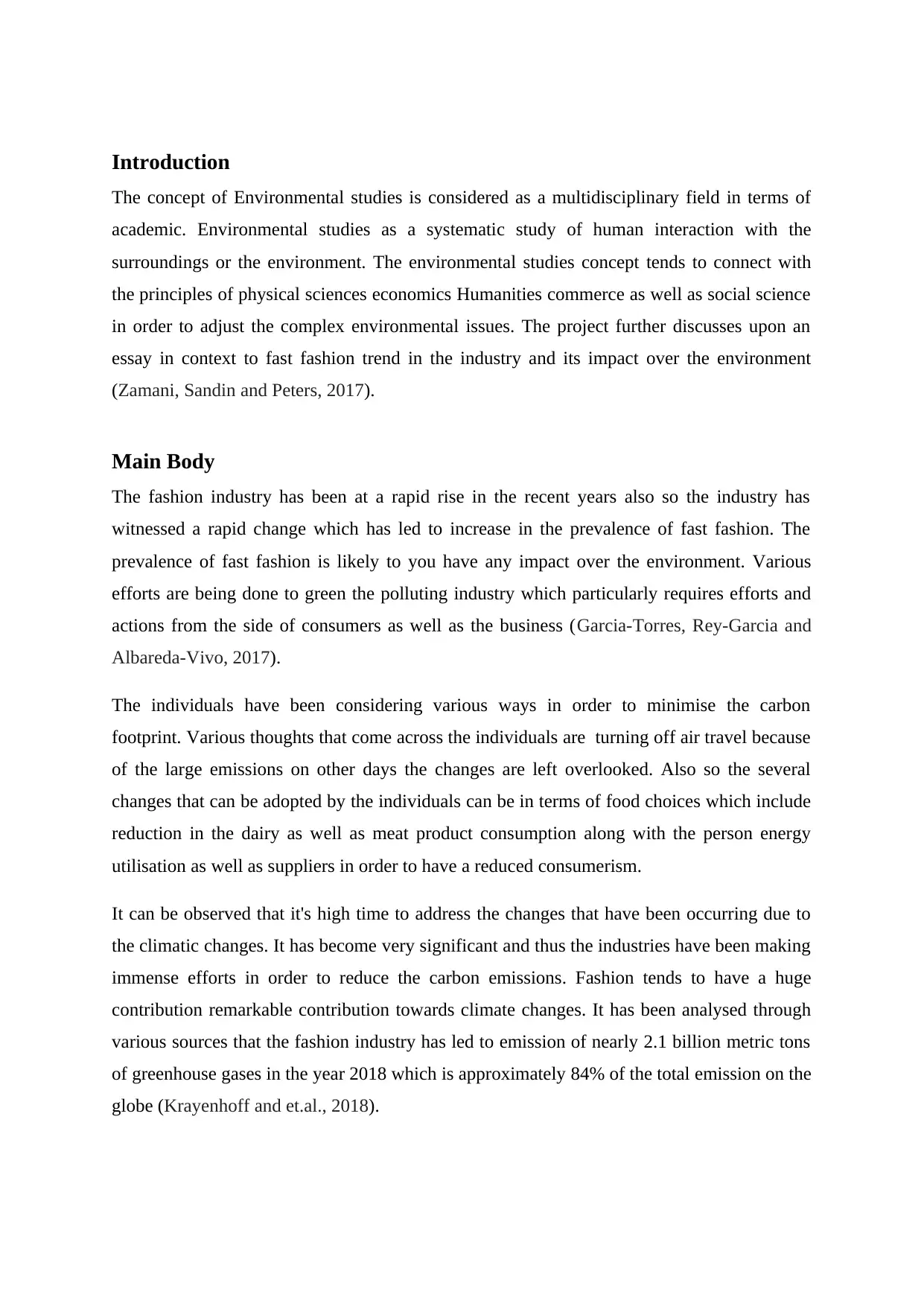
Introduction
The concept of Environmental studies is considered as a multidisciplinary field in terms of
academic. Environmental studies as a systematic study of human interaction with the
surroundings or the environment. The environmental studies concept tends to connect with
the principles of physical sciences economics Humanities commerce as well as social science
in order to adjust the complex environmental issues. The project further discusses upon an
essay in context to fast fashion trend in the industry and its impact over the environment
(Zamani, Sandin and Peters, 2017).
Main Body
The fashion industry has been at a rapid rise in the recent years also so the industry has
witnessed a rapid change which has led to increase in the prevalence of fast fashion. The
prevalence of fast fashion is likely to you have any impact over the environment. Various
efforts are being done to green the polluting industry which particularly requires efforts and
actions from the side of consumers as well as the business (Garcia-Torres, Rey-Garcia and
Albareda-Vivo, 2017).
The individuals have been considering various ways in order to minimise the carbon
footprint. Various thoughts that come across the individuals are turning off air travel because
of the large emissions on other days the changes are left overlooked. Also so the several
changes that can be adopted by the individuals can be in terms of food choices which include
reduction in the dairy as well as meat product consumption along with the person energy
utilisation as well as suppliers in order to have a reduced consumerism.
It can be observed that it's high time to address the changes that have been occurring due to
the climatic changes. It has become very significant and thus the industries have been making
immense efforts in order to reduce the carbon emissions. Fashion tends to have a huge
contribution remarkable contribution towards climate changes. It has been analysed through
various sources that the fashion industry has led to emission of nearly 2.1 billion metric tons
of greenhouse gases in the year 2018 which is approximately 84% of the total emission on the
globe (Krayenhoff and et.al., 2018).
The concept of Environmental studies is considered as a multidisciplinary field in terms of
academic. Environmental studies as a systematic study of human interaction with the
surroundings or the environment. The environmental studies concept tends to connect with
the principles of physical sciences economics Humanities commerce as well as social science
in order to adjust the complex environmental issues. The project further discusses upon an
essay in context to fast fashion trend in the industry and its impact over the environment
(Zamani, Sandin and Peters, 2017).
Main Body
The fashion industry has been at a rapid rise in the recent years also so the industry has
witnessed a rapid change which has led to increase in the prevalence of fast fashion. The
prevalence of fast fashion is likely to you have any impact over the environment. Various
efforts are being done to green the polluting industry which particularly requires efforts and
actions from the side of consumers as well as the business (Garcia-Torres, Rey-Garcia and
Albareda-Vivo, 2017).
The individuals have been considering various ways in order to minimise the carbon
footprint. Various thoughts that come across the individuals are turning off air travel because
of the large emissions on other days the changes are left overlooked. Also so the several
changes that can be adopted by the individuals can be in terms of food choices which include
reduction in the dairy as well as meat product consumption along with the person energy
utilisation as well as suppliers in order to have a reduced consumerism.
It can be observed that it's high time to address the changes that have been occurring due to
the climatic changes. It has become very significant and thus the industries have been making
immense efforts in order to reduce the carbon emissions. Fashion tends to have a huge
contribution remarkable contribution towards climate changes. It has been analysed through
various sources that the fashion industry has led to emission of nearly 2.1 billion metric tons
of greenhouse gases in the year 2018 which is approximately 84% of the total emission on the
globe (Krayenhoff and et.al., 2018).
⊘ This is a preview!⊘
Do you want full access?
Subscribe today to unlock all pages.

Trusted by 1+ million students worldwide
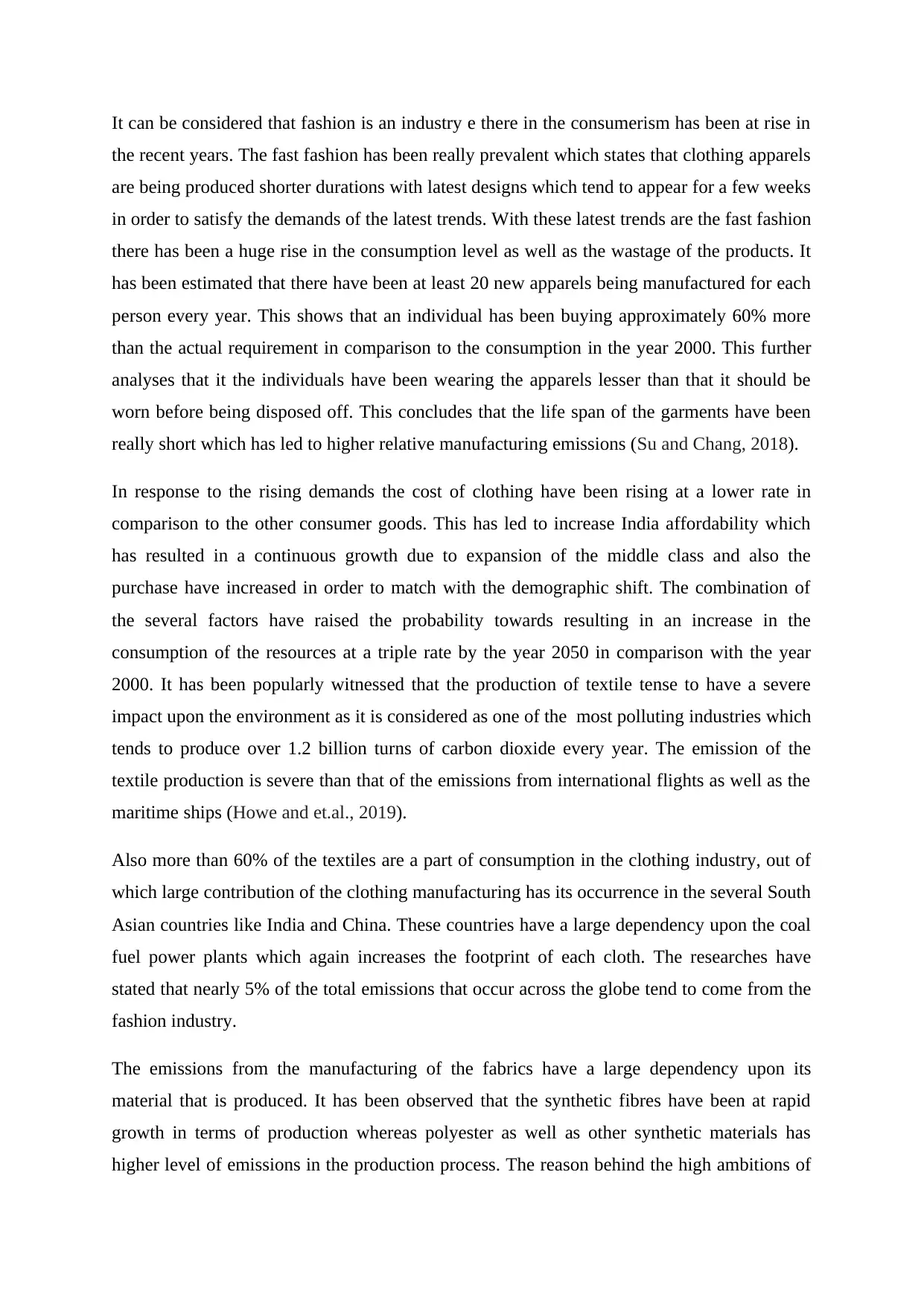
It can be considered that fashion is an industry e there in the consumerism has been at rise in
the recent years. The fast fashion has been really prevalent which states that clothing apparels
are being produced shorter durations with latest designs which tend to appear for a few weeks
in order to satisfy the demands of the latest trends. With these latest trends are the fast fashion
there has been a huge rise in the consumption level as well as the wastage of the products. It
has been estimated that there have been at least 20 new apparels being manufactured for each
person every year. This shows that an individual has been buying approximately 60% more
than the actual requirement in comparison to the consumption in the year 2000. This further
analyses that it the individuals have been wearing the apparels lesser than that it should be
worn before being disposed off. This concludes that the life span of the garments have been
really short which has led to higher relative manufacturing emissions (Su and Chang, 2018).
In response to the rising demands the cost of clothing have been rising at a lower rate in
comparison to the other consumer goods. This has led to increase India affordability which
has resulted in a continuous growth due to expansion of the middle class and also the
purchase have increased in order to match with the demographic shift. The combination of
the several factors have raised the probability towards resulting in an increase in the
consumption of the resources at a triple rate by the year 2050 in comparison with the year
2000. It has been popularly witnessed that the production of textile tense to have a severe
impact upon the environment as it is considered as one of the most polluting industries which
tends to produce over 1.2 billion turns of carbon dioxide every year. The emission of the
textile production is severe than that of the emissions from international flights as well as the
maritime ships (Howe and et.al., 2019).
Also more than 60% of the textiles are a part of consumption in the clothing industry, out of
which large contribution of the clothing manufacturing has its occurrence in the several South
Asian countries like India and China. These countries have a large dependency upon the coal
fuel power plants which again increases the footprint of each cloth. The researches have
stated that nearly 5% of the total emissions that occur across the globe tend to come from the
fashion industry.
The emissions from the manufacturing of the fabrics have a large dependency upon its
material that is produced. It has been observed that the synthetic fibres have been at rapid
growth in terms of production whereas polyester as well as other synthetic materials has
higher level of emissions in the production process. The reason behind the high ambitions of
the recent years. The fast fashion has been really prevalent which states that clothing apparels
are being produced shorter durations with latest designs which tend to appear for a few weeks
in order to satisfy the demands of the latest trends. With these latest trends are the fast fashion
there has been a huge rise in the consumption level as well as the wastage of the products. It
has been estimated that there have been at least 20 new apparels being manufactured for each
person every year. This shows that an individual has been buying approximately 60% more
than the actual requirement in comparison to the consumption in the year 2000. This further
analyses that it the individuals have been wearing the apparels lesser than that it should be
worn before being disposed off. This concludes that the life span of the garments have been
really short which has led to higher relative manufacturing emissions (Su and Chang, 2018).
In response to the rising demands the cost of clothing have been rising at a lower rate in
comparison to the other consumer goods. This has led to increase India affordability which
has resulted in a continuous growth due to expansion of the middle class and also the
purchase have increased in order to match with the demographic shift. The combination of
the several factors have raised the probability towards resulting in an increase in the
consumption of the resources at a triple rate by the year 2050 in comparison with the year
2000. It has been popularly witnessed that the production of textile tense to have a severe
impact upon the environment as it is considered as one of the most polluting industries which
tends to produce over 1.2 billion turns of carbon dioxide every year. The emission of the
textile production is severe than that of the emissions from international flights as well as the
maritime ships (Howe and et.al., 2019).
Also more than 60% of the textiles are a part of consumption in the clothing industry, out of
which large contribution of the clothing manufacturing has its occurrence in the several South
Asian countries like India and China. These countries have a large dependency upon the coal
fuel power plants which again increases the footprint of each cloth. The researches have
stated that nearly 5% of the total emissions that occur across the globe tend to come from the
fashion industry.
The emissions from the manufacturing of the fabrics have a large dependency upon its
material that is produced. It has been observed that the synthetic fibres have been at rapid
growth in terms of production whereas polyester as well as other synthetic materials has
higher level of emissions in the production process. The reason behind the high ambitions of
Paraphrase This Document
Need a fresh take? Get an instant paraphrase of this document with our AI Paraphraser
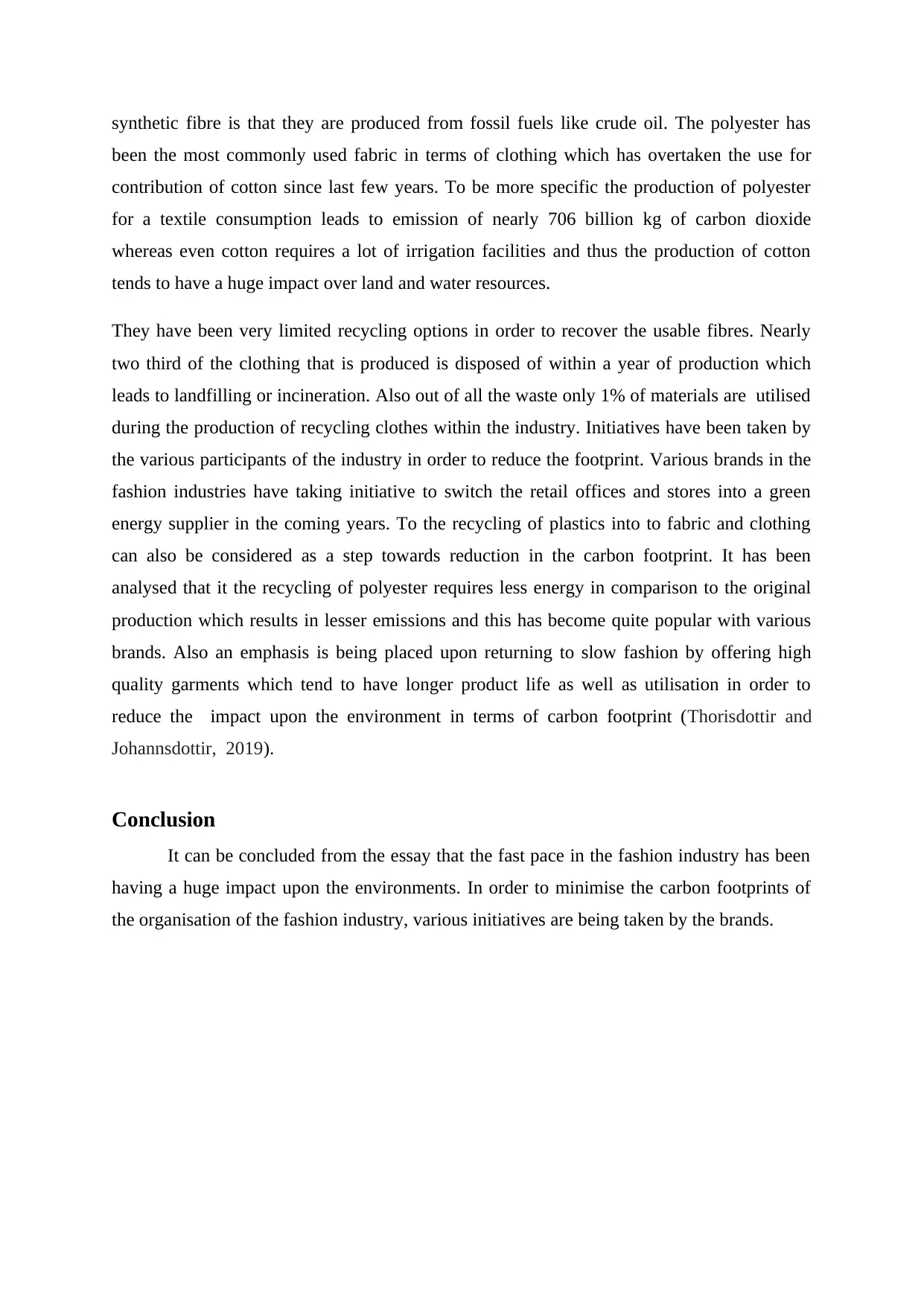
synthetic fibre is that they are produced from fossil fuels like crude oil. The polyester has
been the most commonly used fabric in terms of clothing which has overtaken the use for
contribution of cotton since last few years. To be more specific the production of polyester
for a textile consumption leads to emission of nearly 706 billion kg of carbon dioxide
whereas even cotton requires a lot of irrigation facilities and thus the production of cotton
tends to have a huge impact over land and water resources.
They have been very limited recycling options in order to recover the usable fibres. Nearly
two third of the clothing that is produced is disposed of within a year of production which
leads to landfilling or incineration. Also out of all the waste only 1% of materials are utilised
during the production of recycling clothes within the industry. Initiatives have been taken by
the various participants of the industry in order to reduce the footprint. Various brands in the
fashion industries have taking initiative to switch the retail offices and stores into a green
energy supplier in the coming years. To the recycling of plastics into to fabric and clothing
can also be considered as a step towards reduction in the carbon footprint. It has been
analysed that it the recycling of polyester requires less energy in comparison to the original
production which results in lesser emissions and this has become quite popular with various
brands. Also an emphasis is being placed upon returning to slow fashion by offering high
quality garments which tend to have longer product life as well as utilisation in order to
reduce the impact upon the environment in terms of carbon footprint (Thorisdottir and
Johannsdottir, 2019).
Conclusion
It can be concluded from the essay that the fast pace in the fashion industry has been
having a huge impact upon the environments. In order to minimise the carbon footprints of
the organisation of the fashion industry, various initiatives are being taken by the brands.
been the most commonly used fabric in terms of clothing which has overtaken the use for
contribution of cotton since last few years. To be more specific the production of polyester
for a textile consumption leads to emission of nearly 706 billion kg of carbon dioxide
whereas even cotton requires a lot of irrigation facilities and thus the production of cotton
tends to have a huge impact over land and water resources.
They have been very limited recycling options in order to recover the usable fibres. Nearly
two third of the clothing that is produced is disposed of within a year of production which
leads to landfilling or incineration. Also out of all the waste only 1% of materials are utilised
during the production of recycling clothes within the industry. Initiatives have been taken by
the various participants of the industry in order to reduce the footprint. Various brands in the
fashion industries have taking initiative to switch the retail offices and stores into a green
energy supplier in the coming years. To the recycling of plastics into to fabric and clothing
can also be considered as a step towards reduction in the carbon footprint. It has been
analysed that it the recycling of polyester requires less energy in comparison to the original
production which results in lesser emissions and this has become quite popular with various
brands. Also an emphasis is being placed upon returning to slow fashion by offering high
quality garments which tend to have longer product life as well as utilisation in order to
reduce the impact upon the environment in terms of carbon footprint (Thorisdottir and
Johannsdottir, 2019).
Conclusion
It can be concluded from the essay that the fast pace in the fashion industry has been
having a huge impact upon the environments. In order to minimise the carbon footprints of
the organisation of the fashion industry, various initiatives are being taken by the brands.
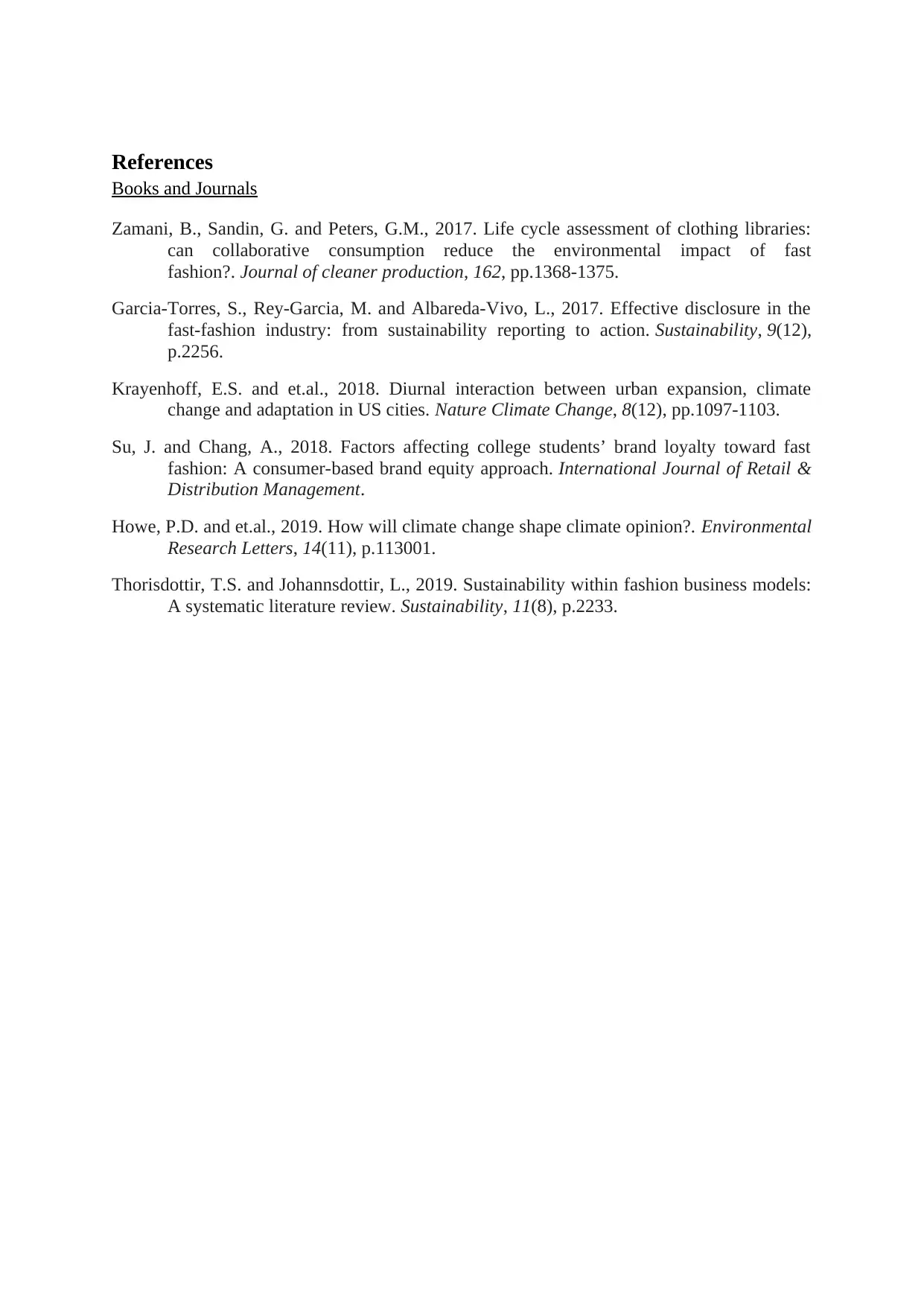
References
Books and Journals
Zamani, B., Sandin, G. and Peters, G.M., 2017. Life cycle assessment of clothing libraries:
can collaborative consumption reduce the environmental impact of fast
fashion?. Journal of cleaner production, 162, pp.1368-1375.
Garcia-Torres, S., Rey-Garcia, M. and Albareda-Vivo, L., 2017. Effective disclosure in the
fast-fashion industry: from sustainability reporting to action. Sustainability, 9(12),
p.2256.
Krayenhoff, E.S. and et.al., 2018. Diurnal interaction between urban expansion, climate
change and adaptation in US cities. Nature Climate Change, 8(12), pp.1097-1103.
Su, J. and Chang, A., 2018. Factors affecting college students’ brand loyalty toward fast
fashion: A consumer-based brand equity approach. International Journal of Retail &
Distribution Management.
Howe, P.D. and et.al., 2019. How will climate change shape climate opinion?. Environmental
Research Letters, 14(11), p.113001.
Thorisdottir, T.S. and Johannsdottir, L., 2019. Sustainability within fashion business models:
A systematic literature review. Sustainability, 11(8), p.2233.
Books and Journals
Zamani, B., Sandin, G. and Peters, G.M., 2017. Life cycle assessment of clothing libraries:
can collaborative consumption reduce the environmental impact of fast
fashion?. Journal of cleaner production, 162, pp.1368-1375.
Garcia-Torres, S., Rey-Garcia, M. and Albareda-Vivo, L., 2017. Effective disclosure in the
fast-fashion industry: from sustainability reporting to action. Sustainability, 9(12),
p.2256.
Krayenhoff, E.S. and et.al., 2018. Diurnal interaction between urban expansion, climate
change and adaptation in US cities. Nature Climate Change, 8(12), pp.1097-1103.
Su, J. and Chang, A., 2018. Factors affecting college students’ brand loyalty toward fast
fashion: A consumer-based brand equity approach. International Journal of Retail &
Distribution Management.
Howe, P.D. and et.al., 2019. How will climate change shape climate opinion?. Environmental
Research Letters, 14(11), p.113001.
Thorisdottir, T.S. and Johannsdottir, L., 2019. Sustainability within fashion business models:
A systematic literature review. Sustainability, 11(8), p.2233.
⊘ This is a preview!⊘
Do you want full access?
Subscribe today to unlock all pages.

Trusted by 1+ million students worldwide
1 out of 6
Related Documents
Your All-in-One AI-Powered Toolkit for Academic Success.
+13062052269
info@desklib.com
Available 24*7 on WhatsApp / Email
![[object Object]](/_next/static/media/star-bottom.7253800d.svg)
Unlock your academic potential
Copyright © 2020–2025 A2Z Services. All Rights Reserved. Developed and managed by ZUCOL.




